Sports
Volleyball | The First Spring
NASHVILLE, Tenn. — Spring isn’t the show in college volleyball. Spring is rehearsal season for fall’s curtain raising, complete with dress rehearsals in as many as four exhibition matches. Spring isn’t supposed to be the destination. But darned if Nashville’s Brentwood High School didn’t feel like the place to be to Kati Berezowitz on the evening […]
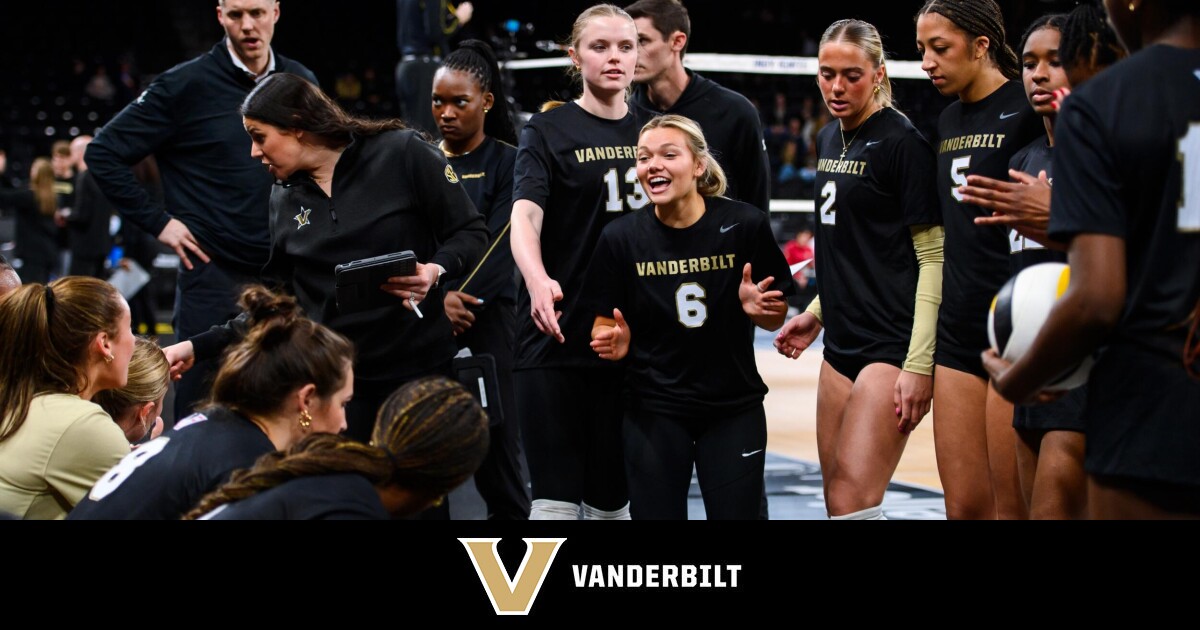
NASHVILLE, Tenn. — Spring isn’t the show in college volleyball. Spring is rehearsal season for fall’s curtain raising, complete with dress rehearsals in as many as four exhibition matches. Spring isn’t supposed to be the destination. But darned if Nashville’s Brentwood High School didn’t feel like the place to be to Kati Berezowitz on the evening of March 21.
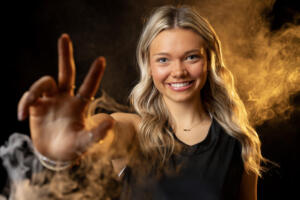 Berezowitz was supposed to be in high school gyms this spring. But not this high school gym, as Vanderbilt took the court in any sort of varsity match for the first time since 1980. A midyear enrollee from Wisconsin who completed high school in December, she spent the fall playing against rivals with names like Wetosha Central. In Brentwood’s full-to-capacity gym, the rival on the other side of the net was the University of Tennessee.
Berezowitz was supposed to be in high school gyms this spring. But not this high school gym, as Vanderbilt took the court in any sort of varsity match for the first time since 1980. A midyear enrollee from Wisconsin who completed high school in December, she spent the fall playing against rivals with names like Wetosha Central. In Brentwood’s full-to-capacity gym, the rival on the other side of the net was the University of Tennessee.
“It was honestly nothing like what I was expecting,” Berezowitz marveled some weeks later. “I was expecting maybe a half full gym—I don’t even know what I was expecting. All I know is it wasn’t that. There were so many people. The energy was amazing. The support we’ve seen around being the first team to bring volleyball back is crazy.”
Berezowitz is the youngest of three Division I volleyball-playing sisters, along with former Kentucky national champion Maddie and current Wildcat Molly. She’s also the smallest of the sisters—and most anyone else on a Division I court. Being tall isn’t a requirement for a libero/defensive specialist. Still, at 5-foot-3, she’s used to the looks that greet her when she and teammates enter a room or she wears her Vandy Volleyball gear around town. The looks that suggests someone is wondering if she’s a player or manager.
It’s tempting to define Berezowitz in comparison to others, by the sisters she has or the height she doesn’t. She’s more interested in establishing who she is and discovering what she can be. It’s why she gladly traded her senior prom for a freshman college writing seminar. And it’s why she welcomed the nervous energy, even the stage fright, bubbling up in the moments before the exhibition against the Lady Vols. She isn’t yet a starter, let alone a star. But at Vanderbilt, she isn’t following in anyone’s footsteps. With her teammates, she gets to define a program and set the standard against which others will be compared.
For Berezowitz and more than a dozen women like her, Vanderbilt was the place to be this spring. And there was no chance she was going to miss it.
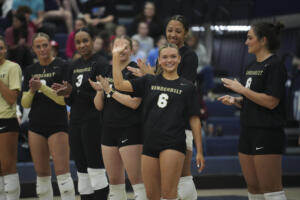
“I was happy that I was still able to be the player I know how to be—I didn’t change who I am. I think the best things I bring to the court are my communication and my ability to lead. Not losing that when I got to college was a big thing for me.”
Kati Berezowitz
Shaped by a Volleyball Family
Somewhere in her family’s Burlington, Wisconsin home, there are photos of Berezowitz, not much more than 10 years old and probably stretching to reach 4 feet, standing next to Anders Nelson, still very much 6-foot-9. There is some history here.
Long before he was Vanderbilt’s head coach, Nelson encountered a family’s passion for volleyball. Some years ago, when he was still a Kentucky assistant coach, Berezowitz’s grandparents approached him in an airport. He does stand out in such settings. After reminiscing about their shared Wisconsin roots, they confided that their granddaughter Maddie wanted to play for the Wildcats. It was hardly the first time someone lobbied him on behalf of a family member. Most efforts came to nothing. But Maddie Berezowitz proved persistent, a decorated high school player who always seemed at the hub of teams that maximized their potential—winning two state titles and reaching three finals.
Maddie became an integral part of the culture at Kentucky, even without playing extensively for much of her time in Lexington. She won the NCAA Elite 90 Award for volleyball, recognizing academic achievement among student-athletes competing at the top level. She co-hosted a popular podcast with then-teammate and current Vanderbilt assistant coach Azhani Tealer. And sure enough, she was part of another championship.
“The whole family understands what it means to be on a team,” Nelson said. “Probably better than any family I’ve been able to interact with. They understand that hard work is how they get what they want—they have a really clear understanding that is how you get rewards. That’s a very cool thing and just speaks to parents who have done a terrific job.”
Maddie, Molly and Kati argued as regularly as expected of siblings—about who was the best volleyball player or athlete or a hundred other things. Also like many siblings (and including Kati’s older brother Joey, now a college basketball player), they wanted each other to succeed against everyone else. If Kati is these days determined to forge her own path, it’s because she so badly wanted to be like her sisters when she was younger. Trying to keep up with them—and get a word in edgewise—explains why, by her own admission, she’s now the loudest of the bunch. But they also taught her to be strong and selfless.
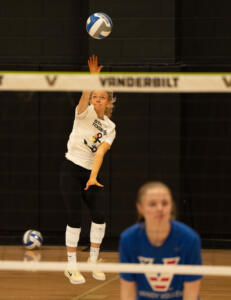 The age difference meant that was particularly true in the case of Maddie, whose entire collegiate journey played out while Kati was still in middle and high school.
The age difference meant that was particularly true in the case of Maddie, whose entire collegiate journey played out while Kati was still in middle and high school.
“She was a good example of what it means to be a team player, and that definitely shaped my understanding of the game and college volleyball,” Berezowitz said. “Not everybody is going to be the star. Not everybody can be the star. But everybody has a role. For me, coming into Vanderbilt a semester early, it was going to be hard. But I think having her example in the back of my mind was calming.”
But there was also particular appeal to a part of the Vanderbilt opportunity that Nelson stressed with everyone he and his staff recruited—something that no other school could. Rather than being next in line elsewhere, they could be first at Vanderbilt.
Kati was a freshman in high school when Vanderbilt reinstated volleyball as its 17th varsity sport and a sophomore when Nelson was introduced as head coach. Early in the recruiting process, she recalled him saying that as much as he enjoyed coaching Maddie, this wasn’t about continuing a story. This had to be her journey.
“That was really reassuring because I know he’s not going to make me be my sister,” Berezowitz said. “He’s not going to compare me to Maddie because we’re two different people. He sees that, which is something that I really respect about him.”
Getting an Early Start
She liked everything about Vanderbilt. She connected with the coaching staff Nelson assembled, first Lauren Plum and Russell Corbelli and then, of course, a very familiar face in Tealer. Looking for a place where she could envision spending four years, volleyball aside, she loved Nashville. She just had one question for Nelson: Could she enroll early?
Midyear enrollment is an increasingly common phenomenon for student-athletes in fall sports who are looking to ease their transition to college. From early in her own high school days, Kati worked with her parents, both educators, as well as Burlington school counselors to work ahead and keep her options open.
When Nelson confirmed it was possible, she scrapped her remaining visits and committed.
In addition to Berezowitz, Kayla Dunlap, Taylor Porter and Maya Witherspoon enrolled at midyear, giving all four valuable time to adjust to college academically and socially and giving the volleyball program the necessary quorum to accelerate growth on the court.
“Our administration was really open and helpful with me wanting to get as much of our team here as possible,” said Nelson, also praising the bridge programming for midyear students put on by the Ingram Center for Student-Athlete Success. “They understood why it was so important for this group, particularly, just knowing that we were going to rely on a lot of young players in a lot of different ways.”
A Spring Unlike Any Other
Berezowitz also played softball into her high school years, but there was never much doubt as to which sport was pastime and which was passion. Both involved teamwork and camaraderie. Both provided the competitive adrenaline of winning and losing. But where softball forced her to wait innings before getting another chance after a bad at-bat or an error in the field, redemption awaited on the next point in volleyball. If you were humble enough to embrace your stumbles, you could see yourself growing from them in real time.
The deserved fuss and fanfare around the opening exhibition notwithstanding, that’s what spring volleyball is all about. It isn’t glamorous. It’s also where Berezowitz was at her most influential for a program doing everything for the first time. For all the information she had gleaned from watching her sisters, and for all the planning she put into enrolling early, college wasn’t a breeze. Still, she set the tone for a group of midyear enrollees who were anything but timid or hesitant to speak up—and not just when things were going well.
The team has weekly “intention” meetings intended to help individuals sharpen their focus on what they want to get out of the days ahead and just generally where they’re at. In one, Nelson opened the floor to discussion, and instead of the usual awkward silence familiar in such settings the world over, Berezowitz jumped in with unflinching self-criticism.
“She was very open and honest about some of her struggles and wanting to learn and grow faster than she was,” Nelson said. “She’ll look back on that and think ‘Well, yeah, everyone goes through that.’ But when you are going through it, you don’t see it like that. She was really transparent and vulnerable with her teammates about those struggles. It’s pretty mature to acknowledge those feelings, but then sharing them is another level.”
Vanderbilt’s first spring was constantly useful and occasionally revelatory. It highlighted how much of a gem the program has in Dunlap, a Nashville native and perhaps the most improved player over the course of her first semester on campus. It showcased Reese Animashaun, an integral part of the program’s original signing class, as a standout who could pass against elite serving opposition and whose skills grew across the board.
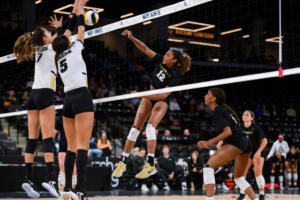
Early enrollee and Nashville native Kayla Dunlap earned rave reviews in her first spring (Vanderbilt Athletics).
But as much as the highlight-reel moments and star turns, Vanderbilt had to find out if the culture seeded over a short period of time had taken root. The Commodores had to show they could learn from the sometimes humbling tests that come with competing for playing time and facing another team across the net, even in matches that don’t count.
They needed to embrace all those things that Berezowitz has always loved about the sport and the rewards it affords those humble enough to learn.
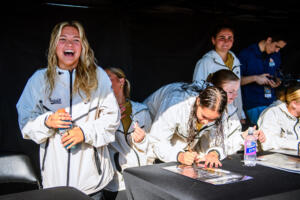
Berezowitz and her teammates sign autographs following Vanderbilt’s spring match against Purdue in Fishers, Ind. (Vanderbilt Athletics).
By the end of the semester, she started to see the gains for her perseverance, her passing skills and strong platform coming to the fore. Now it’s up to her to continue working on her own before the team reconvenes for a summer trip to Asia.
“I was happy that I was still able to be the player I know how to be—I didn’t change who I am,” Berezowitz said. “I think the best things I bring to the court are my communication and my ability to lead. Not losing that when I got to college was a big thing for me. If anything, I grew because I played with different players, different situations, different roles.”
The Place to Be First
 Berezowitz’s past few months were a whirlwind. There was the first day on her own after her parents departed and her first volleyball practice. There was her first college class—English composition. There was the first midterm that didn’t go quite as well as she hoped—and the first final that did. There was also, of course, the first match against Tennessee.
Berezowitz’s past few months were a whirlwind. There was the first day on her own after her parents departed and her first volleyball practice. There was her first college class—English composition. There was the first midterm that didn’t go quite as well as she hoped—and the first final that did. There was also, of course, the first match against Tennessee.
Amid it all, there was also the first night when it all felt like it made sense.
Initially, she tried hard to fit in and be what a college student-athlete was supposed to be. Whatever that was. Mostly, it was exhausting. Then a teammate texted her one evening that a bunch of them were hanging out in one of their rooms. She should come by. They had practice the next morning, but as the hours crept past, no one moved to call it a night.
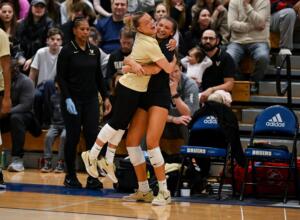 She could have been at home in Wisconsin, with someone else to do the laundry and an easy senior spring to coast through in school. But it wouldn’t have felt like this.
She could have been at home in Wisconsin, with someone else to do the laundry and an easy senior spring to coast through in school. But it wouldn’t have felt like this.
“I think that that’s when I really started to feel like I belonged,” Berezowitz said. “I started to connect with the girls on a deeper level. Honestly, that was my favorite memory, which is weird because we weren’t even doing anything fun or crazy. We were sitting in a dorm talking, But I think that’s where I became friends with all of them.”
The first official match looms in August. And there will be more firsts for Vanderbilt volleyball in the years to come—the first SEC victory, the first postseason match, maybe even the first national championship somewhere down the road. They will be earned by women who dare to lead the program forward, following in the footsteps of a group who came through the first spring and walked onto that Brentwood court.
“One of the coolest parts of the experience was the little girls wearing Vandy volleyball shirts—I had a lot of girls come up to me after the game asking for pictures,” Berezowitz said. “I never expected it to be like this. It was super, super cool. I’m looking forward to kids in Nashville being able to look up to us and try to play for Vandy volleyball one day. I think it’s really cool that we can pave the way for Nashville volleyball.”
Photos by Alondra Munoz Sandoval, Joe Howell and Pilar Ballough.
Sports
Footvolley league returns to Tel Aviv bringing summer energy
“We’re proud to turn the beaches of Tel Aviv–Jaffa into a hub for sports, community, and culture – open and accessible to people of all ages and levels,” said Zipi Brand, Deputy Mayor and head of the city’s Beaches and Parks Division. “The footvolley league is part of our broader push to develop beach sports […]
“We’re proud to turn the beaches of Tel Aviv–Jaffa into a hub for sports, community, and culture – open and accessible to people of all ages and levels,” said Zipi Brand, Deputy Mayor and head of the city’s Beaches and Parks Division. “The footvolley league is part of our broader push to develop beach sports across the city. Just this year, we’ve added dozens of volleyball and footvolley nets along the coastline for free public use. The municipality will continue working to make our beaches active, inclusive, and full of life.”
Sports
Volleyball adds Riley Whitesides as Assistant Coach » Urban Milwaukee
MILWAUKEE – Riley Whitesides joins the Marquette University women’s volleyball staff as an assistant coach, first-year head coach Tom Mendoza has announced. “I’ve known Riley for a long time and we could not be adding a better person to the program and mentor for our student-athletes.” Mendoza said. “She’s successful because of the work she […]
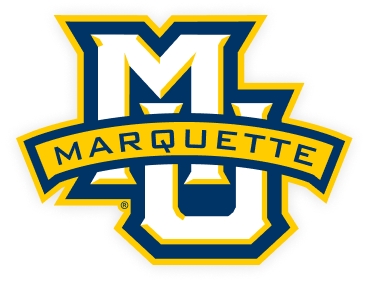
MILWAUKEE – Riley Whitesides joins the Marquette University women’s volleyball staff as an assistant coach, first-year head coach Tom Mendoza has announced.
“I’ve known Riley for a long time and we could not be adding a better person to the program and mentor for our student-athletes.” Mendoza said. “She’s successful because of the work she puts in and the relationships she builds. I am excited to work with her and the impact she will have on Marquette Volleyball.”
She joins associate head coach Ethan Pheister and fellow assistant coach Stef Jankiewicz on the MU staff.
Whitesides played five seasons for Mendoza at the University of South Carolina and was a First Team All-Southeastern Conference and AVCA All-Region selection as a graduate student in the fall of 2024. The native of Greenville, South Carolina averaged 4.47 kills per set as a grad student to rank among the top-20 nationally while hitting .241.
Whitesides ended her indoor career fifth in program history in kills (1,452), second in service aces (100), ninth in digs (920) and fourth in points scored (1,645.0).
She also excelled academically at South Carolina, twice earning College Sports Communicators Academic All-District recognition and SEC academic honors. Whitesides graduated with a bachelor’s degree in psychology in May 2024 and earned a Master of Business Administration this spring.
Most recently, Whitesides completed her third season playing beach volleyball in Columbia with an 18-13 record this spring after a 20-15 mark during 2024. Overall, she boasts a career 38-27 record in dual action on the sand.
Earlier this spring the Golden Eagles announced their non-conference schedule for the fall of 2025, featuring a match against Wisconsin at Fiserv Forum on Wednesday, Sept. 17 in addition to key matchups with WKU, Dayton, Florida and Minnesota at the Al McGuire Center. Marquette went 25-9 in the fall of 2024 and made its third NCAA Regional appearance before falling to the eventual NCAA Champion in the regional semifinals.
Keep up with the Marquette University women’s volleyball program through social media by following on X (@MarquetteVB) and Instagram (@MarquetteVB) and ‘liking’ on Facebook (/MarquetteVolleyball).
NOTE: This press release was submitted to Urban Milwaukee and was not written by an Urban Milwaukee writer. While it is believed to be reliable, Urban Milwaukee does not guarantee its accuracy or completeness.
Mentioned in This Press Release
Recent Press Releases by Marquette Athletics



Sports
Six Navy Football Players Named Preseason All-AAC in National Magazine
The Navy Midshipmen have six players on Lindy’s Sports’ all-American Athletic Conference preseason team, released recently. The publication hit newsstands earlier this month. The publication picked the Midshipmen to win the AAC this season. Navy went 10-3 last season, concluding the campaign with a victory over the Oklahoma Sooners in the Armed Forces Bowl. The […]
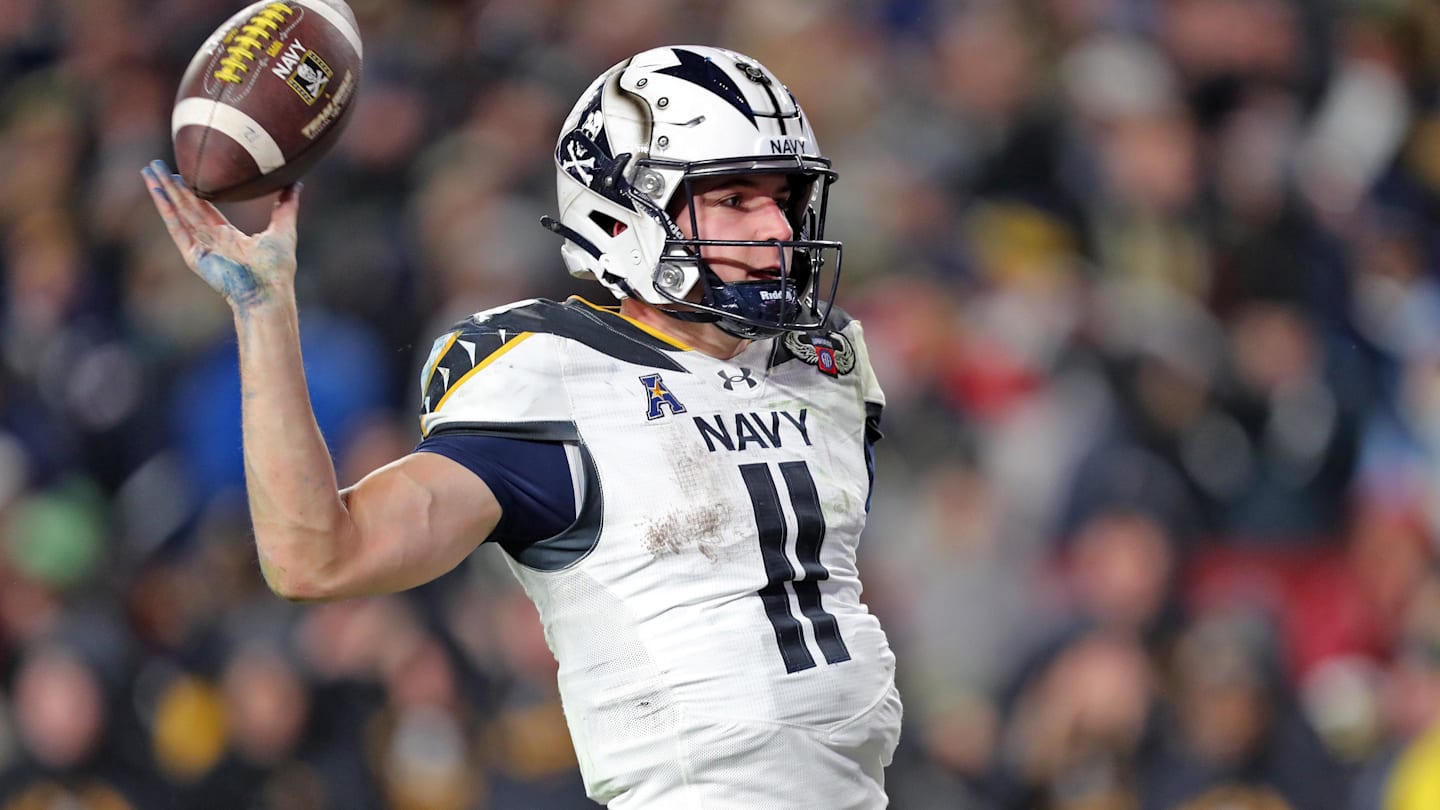
The Navy Midshipmen have six players on Lindy’s Sports’ all-American Athletic Conference preseason team, released recently.
The publication hit newsstands earlier this month. The publication picked the Midshipmen to win the AAC this season.
Navy went 10-3 last season, concluding the campaign with a victory over the Oklahoma Sooners in the Armed Forces Bowl. The season was Navy’s sixth with at least 10 wins and fell one win short of their 11-wins seasons in 2015 and 2019.
More news: Navy Water Polo Star Earns Spot on Prestigious USA Junior National Roster
Quarterback Blake Horvath, wide receiver Eli Heidenreich, defensive lineman Landon Robinson and defensive back Andrew Duhart. Running back Alex Tecza and offensive lineman Ben Purvis were on the second team.
Horvath will be a huge key for the Midshipmen. Horvath emerged as the starter last year and put together a year that helped the Midshipmen win the Commander-in-Chief’s Trophy.
He rushed for 1,246 yards and 17 touchdowns and throw for 1,353 yards with 13 touchdowns and four interceptions. He threw for the 10th most yards in program history. He also became the third quarterback in Navy history to rush and pass for more than 1,200 yards in the same season.
More news: Navy Football’s Stock in American Athletic Conference Title Race Rises
Heidenreich caught six touchdown passes, which tied him for the most in Navy history in a single season. He was also Navy’s first receiver with back-to-back 100-yard receiving games in a decade. He finished the season with 39 receptions for 671 yards and six scores. He also rushed for 444 yards and three touchdowns.
Robinson was named an all-AAC first-team nose guard last year. He finished the season with 61 tackles, 5.5 tackles for loss, four sacks, seven quarterback hurries and two forced fumbles. He was part of the Midshipmen’s defensive effort that ended Army quarterback Bryson Daily’s program record of 10 straight games with 100 or more rushing yards.
Duhart returns after he finished last season with 29 tackles and 1.5 tackles for loss. He also had four pass breakups and a fumble recovery. He has started nearly all of Navy’s games the past two seasons.
More news: Air Force Football Projected for Bounce-Back Season in Mountain West
Tecza was Navy’s second-leading rusher with 576 yards and 8 touchdowns on 125 carries and the third-leading receiver with 229 yards and 2 touchdowns on 12 catches. Purvis was an all-AAC honorable mention last season.
Date, Time, Opponent (TV)
(all times local)
Aug. 30: vs. VMI, 12 p.m., CBSSN
Sept. 6: vs. UAB*, 3:30 p.m., CBSSN
Sept. 13: at Tulsa*, 8 p.m., ESPN+
Sept. 27: vs. Rice*, 3:30 p.m., CBSSN
Oct. 4: vs. Air Force, 12 p.m., CBS
Oct. 11: at Temple*, TBA, TV TBA
Oct. 25: vs. FAU*, 3:30 p.m., CBSSN
Nov. 1: at North Texas*, TBA, TV TBA
Nov. 8: at Notre Dame, 7:30 p.m., NBC
Nov. 15: vs. USF*, 12 p.m., ESPN Family
Nov. 27: at Memphis*, 7:30 p.m., ESPN
Dec. 13: vs. Army West Point, 3 p.m., CBS
(note: Army-Navy game at Baltimore, Md.)
(if Navy qualifies for AAC title game, it will be played Friday, Dec. 5, at site of higher seed)
For More Navy Coverage, Head to Armed Forces Sports On SI
Sports
MLB Takes Minority Stake in Jomboy Media to Strengthen Digital Content Strategy
Major League Baseball (MLB) has acquired a minority stake in digital content company Jomboy Media, formalising a partnership aimed at expanding the league’s reach among younger and more digitally native audiences. The investment was made through MLB’s investment arm, Baseball Endowment L.P. (BELP), which is co-owned by all 30 MLB teams. The deal allows MLB […]

Major League Baseball (MLB) has acquired a minority stake in digital content company Jomboy Media, formalising a partnership aimed at expanding the league’s reach among younger and more digitally native audiences.
The investment was made through MLB’s investment arm, Baseball Endowment L.P. (BELP), which is co-owned by all 30 MLB teams. The deal allows MLB to integrate Jomboy Media’s content capabilities into its digital and event strategies, including activations around marquee fixtures like the All-Star Game and Home Run Derby.
While the financial details of the investment remain confidential, Jomboy Media confirmed it crossed USD $10 million in revenue in 2024 and returned to profitability following a 44% year-on-year revenue increase. The company has also raised $5 million through a funding round led by Connect Ventures and appointed Courtney Hirsch as CEO in March, positioning the business for further growth.
As part of the partnership, Jomboy Media will gain selective access to MLB and team intellectual property, enabling the creation of licensed merchandise—including apparel and home goods—for sale through its direct-to-consumer channels.
Importantly, the partnership preserves editorial independence for Jomboy, a stipulation acknowledged by both parties.
“It was a very important part of the deal that we don’t have editorial control,” said Kenny Gersh, MLB’s Executive VP of Media & Business Development.
Jomboy Media has built a reputation for candid and at times controversial commentary, notably covering incidents such as the Astros’ sign-stealing scandal and umpire disputes. Retaining creative freedom is seen as critical to the brand’s continued appeal and audience engagement.
CEO Courtney Hirsch noted that discussions with MLB had been ongoing since mid-2024.
“It just felt like the right time… they’re really going to let us continue to do our thing,” said Hirsch.
The deal also opens opportunities to expand Jomboy’s IP portfolio and commercial footprint, with co-branded merchandise and broader content distribution planned. Hirsch and founder Jimmy O’Brien formally presented the proposal to MLB’s Investment Committee last week, receiving strong interest from key owners, including committee chair Mark Attanasio and John Henry.
Jomboy Media reports more than 93 million annual social media engagements and has secured brand partnerships with several MLB sponsors, including T-Mobile and Corona.
The strategic investment highlights MLB’s ongoing shift toward non-traditional media and influencer-driven storytelling to reach fragmented audiences. It also reflects a broader trend across global sports leagues—where digital-first platforms are being integrated into rights holder ecosystems through investment, rather than acquisition.
Don’t miss out on the latest in sports business – Subscribe today to the free Ministry of Sport newsletter and stay ahead of the game. For even more exclusive insights, event tickets, professional development and networking events, become a MoS Member today!.
Sports
University of Memphis
EUGENE, Ore. – Memphis throwers Gabriel Koletsi and Sascha Salesius Schmidt are set to make their NCAA Championships debuts on Wednesday, as both will compete on the first day of the NCAA Track and Field Outdoor Championships. The events will go from June 11 to 14 at historic Hayward Field at the University of Oregon. […]
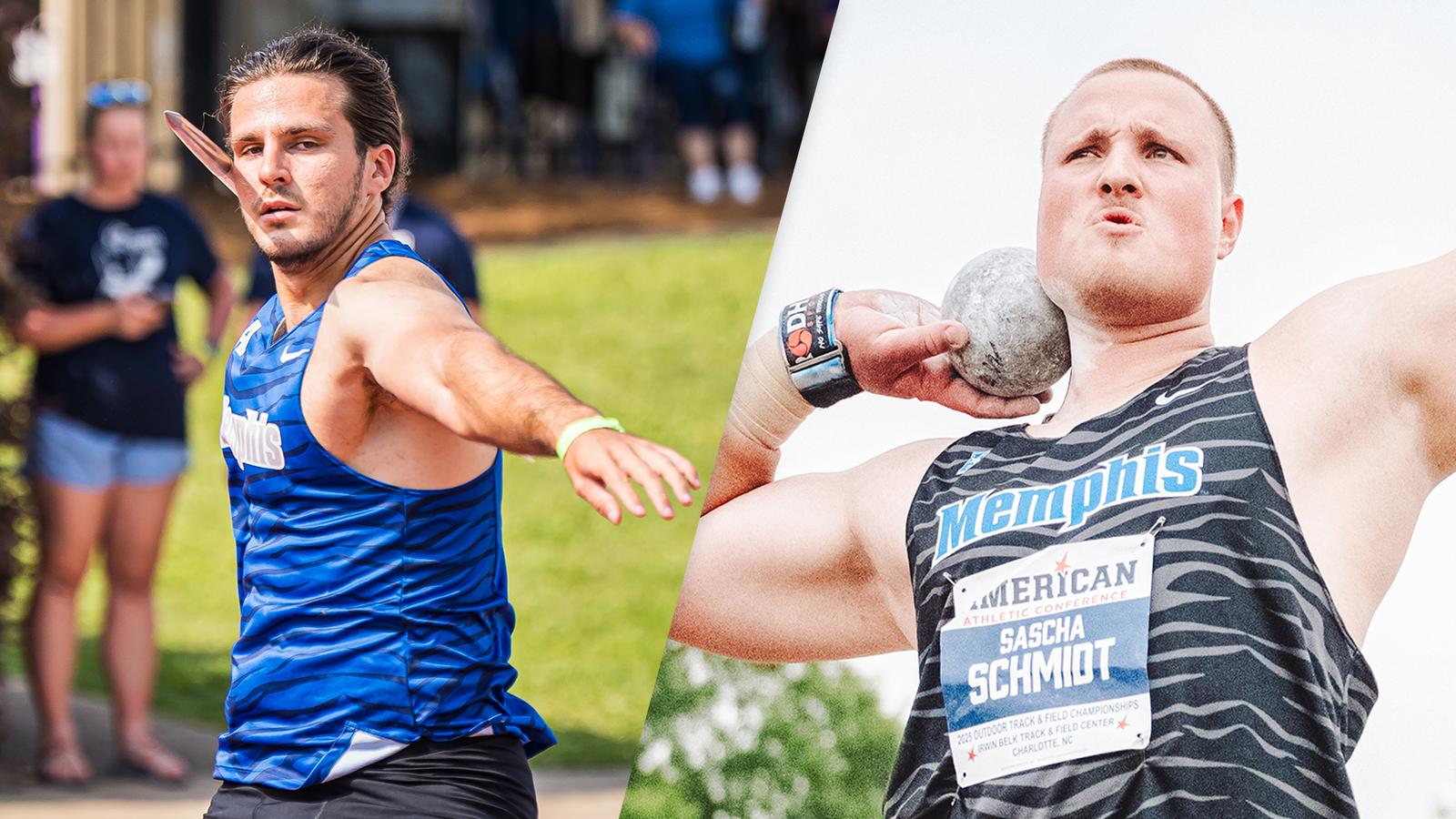
EUGENE, Ore. – Memphis throwers Gabriel Koletsi and Sascha Salesius Schmidt are set to make their NCAA Championships debuts on Wednesday, as both will compete on the first day of the NCAA Track and Field Outdoor Championships.
The events will go from June 11 to 14 at historic Hayward Field at the University of Oregon. A full schedule, live results link and streaming information can be found above.
Koletsi will be the first to represent the Tigers, with the men’s javelin set to begin at 7:15 p.m. CT. After reaching NCAA Regionals each of the last two seasons at UMBC, Koletsi qualified for his first Championships after placing 11th behind a 67.84-meter javelin throw at the East Regional in Jacksonville.
Schmidt also will compete in his first Championships after coming up just short in each of his first two seasons at Memphis. His season-best shot put launch of 18.77 meters placed 12th in the competition to earn him a berth. His competition will begin at 8:10 p.m. CT.
Koletsi is the first javelin thrower to represent Memphis at NCAAs since Mona Jaidi and Ashley Pryke in 2018, and Sascha marks the first shot put qualifier in a decade (Vivian Brandhoff, 2015).
How to follow the Tigers: For complete information on Memphis Tiger Cross Country and Track & Field, visit www.GoTigersGo.com and follow the team’s social media channels on Twitter, Instagram and Facebook.
Sports
Midland Volleyball Schedule released – The Bull
FREMONT, Neb. – Midland University has released its 2025 volleyball schedule, which features 28 regular-season matches ahead of the postseason. The Warriors, under the direction of new head coach Micah Rhodes, will open their campaign August 21 at the Missouri Baptist University Invitational in St. Louis, Missouri. Midland will face a challenging schedule right out […]

FREMONT, Neb. – Midland University has released its 2025 volleyball schedule, which features 28 regular-season matches ahead of the postseason. The Warriors, under the direction of new head coach Micah Rhodes, will open their campaign August 21 at the Missouri Baptist University Invitational in St. Louis, Missouri.
Midland will face a challenging schedule right out of the gate, with seven of its first nine opponents having qualified for the 2024 NAIA National Tournament. In total, 11 of the Warriors’ matches will come against national tournament teams, providing early and consistent tests for a program that has made 11 NAIA Championship appearances in the past 12 seasons.
“We will be challenged, and I couldn’t be more excited to hit the ground running with this particular group of young women,” said Rhodes, who takes over the program following the retirement of longtime head coach Paul Giesselmann. “Opening the season down in St. Louis against four teams that advanced to the NAIA National Tournament final site is about as tough as you can get, but the team will be well-prepared. That level of competition is the standard these players have come to know and expect.”
The 2025 slate opens with four matches over two days in St. Louis, including matchups against perennial powers Viterbo and host Missouri Baptist. After their home opener against York University on August 26, the Warriors head to Omaha for the College of Saint Mary Labor Day Classic, where they will take on four more quality opponents including College of Idaho, Benedictine (Kan.), and The Master’s.
Rhodes has also emphasized growth and development through the junior varsity program, which includes a home JV/Varsity doubleheader against Grand View University and the addition of the program’s first-ever home JV tournament.
“I really want to embrace the concept of using the JV program as developmental for our younger athletes,” he said. “I’m also excited to have added a non-conference home JV/V doubleheader with Grand View to give our home fans another opportunity to see us play.”
Conference play begins September 6 on the road against College of Saint Mary. Midland will play 16 Great Plains Athletic Conference (GPAC) matches, concluding regular-season action at home against Hastings College on November 4.
“As always, our tough preseason and conference schedules are designed to prepare us for when it matters most, which is the postseason and our goal of advancing to Sioux City,” Rhodes said. “We aren’t playing for August and September, but instead for November and December.”
Rhodes also shared his outlook for the program’s new chapter, stating, “I’m excited for the players to embrace the change that comes with new leadership, while remaining true to who we are as a team and program. The standards and expectations are the same. We are competing for a national championship. But my hope is that the players will take pride in beginning a new era of Midland Volleyball.”
Postseason play is set to begin with the GPAC Tournament on November 8, with the NAIA National Championship Opening Round on November 22. The NAIA Championship Final Site will once again take place in Sioux City, Iowa from December 3-9.
Key returners from last year’s squad include All-GPAC First Team honoree and Freshman of the Year Brooklynn Snyder, as well as All-GPAC Honorable Mention selection Cameran Jansky.
2025 Midland Volleyball Schedule Highlights
- Season Opener: August 21 vs. Viterbo University (St. Louis, Mo.)
- Home Opener: August 26 vs. York University (Fremont, Neb.)
- Conference Opener: September 6 at College of Saint Mary
- Homecoming Match: September 27 vs. Dakota Wesleyan University
- Final Home Match: November 4 vs. Hastings College
- NAIA Championship Dates: December 3-9 (Sioux City, Iowa)
-

 NIL2 weeks ago
NIL2 weeks ago2025 NCAA Softball Tournament Bracket: Women’s College World Series bracket, schedule set
-

 Motorsports3 weeks ago
Motorsports3 weeks agoWhy IHOP Rode With Dale Earnhardt Jr. In Amazon NASCAR Debut
-

 Health5 days ago
Health5 days agoOregon track star wages legal battle against trans athlete policy after medal ceremony protest
-

 College Sports2 weeks ago
College Sports2 weeks agoIU basketball recruiting
-

 Professional Sports6 days ago
Professional Sports6 days ago'I asked Anderson privately'… UFC legend retells secret sparring session between Jon Jones …
-

 Professional Sports6 days ago
Professional Sports6 days agoUFC 316 star storms out of Media Day when asked about bitter feud with Rampage Jackson
-

 Rec Sports2 weeks ago
Rec Sports2 weeks agoScott Barker named to lead CCS basketball • SSentinel.com
-

 Rec Sports2 weeks ago
Rec Sports2 weeks agoJ.W. Craft: Investing in Community Through Sports
-

 Youtube3 weeks ago
Youtube3 weeks agoAnt greets A-Rod & Barry Bonds before Game 3
-

 College Sports2 weeks ago
College Sports2 weeks agoOlympic gymnastics champion Mary Lou Retton facing DUI charge











 #HeroesOfTheGame
#HeroesOfTheGame












 Stephen A. responds to LeBron’s NBA coverage criticism | First Take
Stephen A. responds to LeBron’s NBA coverage criticism | First Take



 (via @nbcsportsauthentic/TT)
(via @nbcsportsauthentic/TT)





